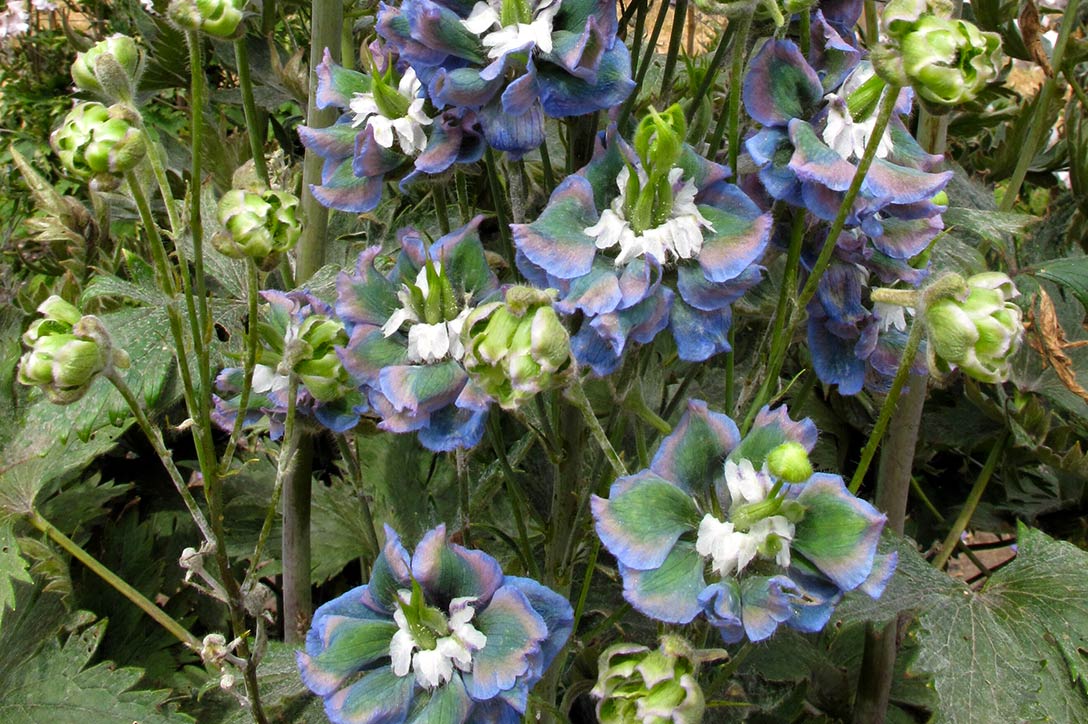Phytoplasmas
The phytoplasmas are a specialised group of bacteria that are transmitted to plants by insect vectors. Many of the symptoms that they cause are quite virus-like. The advent of new diagnostic techniques is greatly increasing the number of phytoplasma diseases recorded.

Quick facts
Scientific name: ‘Candidatus Phytoplasma’, followed by the specific name, e.g. ‘Candidatus Phytoplasma asteris’
Plants affected: Many
Main symptoms: Yellow leaves, ‘little leaf’, green flowers, shoot proliferation, stunting
Caused by: Phytoplasmas
Timing: Depends on host plant; symptoms are often most visible during active growth
What are phytoplasmas?
Symptoms
You may see the following symptoms, many of which result from a hormonal imbalance within the plant:
- Yellowing or reddening of leaves
- Greatly reduced leaf size (‘little leaf’)
- Proliferation of shoots, often with reduced internode length, resulting in dense, crowded, ‘bunchy’ growth (known as a witches’ broom when it affects a woody plant)
- Greening of flowers – this can occur in two ways, either the petals themselves turning green (virescence) or the flower parts being replaced by leaf-like structures (phyllody)
- Stunting and reduction in vigour
- In extreme cases plants may be killed
Control
Non-chemical control
Plants developing a combination of the above symptoms are probably best removed and disposed of, as they could act as a source of the pathogen for other plants.
Chemical control
There are no chemicals available for the control of diseases caused by phytoplasmas. Chemical control of the insect vectors by gardeners is not practical due to the sporadic nature of transmission.
Biology
Phytoplasmas are specialised bacterial pathogens, lacking a cell well and remaining confined to the phloem tissues. There are references going back to the early 17th century to symptoms of diseases that are now known to caused by phytoplasmas. However, because they cannot be grown in artificial culture (hence the ‘Candidatus’ part of the scientific name), and are often present at very low numbers in affected plants, it is only with the advent of DNA-based technology that they can be detected reliably. This has led to a rapid increase in the number of diseases known to be caused by phytoplasmas.
Some phytoplasmas have very wide host ranges and can produce a huge array of symptoms. For example, ‘Candidatus Phytoplasma asteris’ (a member of the aster yellows group) has been recorded on more than 200 plant species, and causes diseases with over 100 different names based on the plant affected and the symptoms produced (e.g. delphinium virescence, mulberry dwarf). Others have more limited host ranges, for example ‘Candidatus Phytoplasma ulmi’ is confined to Ulmus and Zelkova species, causing a damaging disease called elm yellows that is notifiable in the UK.
Some of the most damaging phytoplasma diseases are found in tropical or subtropical climates, for example lethal yellowing of palms. However, certain phytoplasmas can cause significance economic damage in temperate climates. Aster yellows causes yield and quality problems in a wide range of vegetable and ornamental crops, whilst in New Zealand there has been extensive loss of native Cordyline plants due to a disease known as sudden decline of cabbage tree, caused by ‘Candidatus Phytoplasma australiense’.
The vectors of phytoplasmas are leafhoppers, planthoppers and psyllids (suckers), which feed on plants by probing into the phloem vessels. In doing so, they become contaminated with the phytoplasma, which eventually finds its way into the salivary glands so that it can be transmitted to other plants. Phytoplasmas can overwinter either within the insect vector or within perennial host plants.
Just occasionally, infection by a phytoplasma can be beneficial rather than damaging. Free-branching cultivars of poinsettia, producing short plants that branch readily and produce many flowers, have been available to growers for decades. All modern cultivars have this growth habit, but it was not until recently that it was found that this is actually caused by the presence of a phytoplasma in the plant.
See also...
Get involved
The Royal Horticultural Society is the UK’s leading gardening charity. We aim to enrich everyone’s life through plants, and make the UK a greener and more beautiful place.